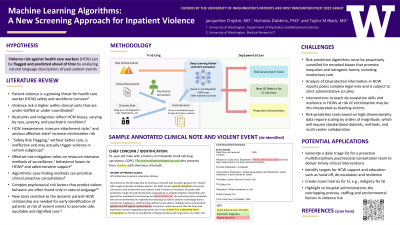Quality and Safety
Session: Poster Session
(157) Machine Learning Algorithms as a New Screening Approach for Inpatient Violence and Psychosocial Intervention

Trainee Involvement: Yes

Jacqueline T. Chipkin, MD (she/her/hers)
PGY-4
University of Washington
Seattle, Washington, United States- TB
Taylor M. Black, MD
Assistant Professor
University of Washington
Seattle, Washington, United States
Presenting Author(s)
Co-Author(s)
Inpatient aggression and violence are broad outcome measures stemming from many psychosomatic etiologies. The implementation of emergency behavioral codes to manage these events has become standard practice1. While acute de-escalation is critical, these protocols emphasize a one-size-fits-all, reactive model of containment rather than a proactive model of prevention and treatment of modifiable factors. As a result, numerous adverse clinical, workplace safety, and financial outcomes ensue. However, little is known about the best way to screen patients at risk for violence in non-psychiatric units. In addition to machine learning from discrete EHR data, natural language processing (NLP) has been shown to predict medical readmission risk by analyzing EHR text2. The importance of narrative data containing psychosocial variables such as poor social support, housing instability, depression, and substance use is uniquely suited for NLP. Therefore, we hypothesize that NLP has a role in screening for patients with psychosomatic complexity and propensity for violent behavior. We will train machine learning algorithms (MLA) to identify high risk patients. The training dataset will consist of patients admitted to medical and surgical units of an academic county hospital over the past two years; we anticipate a sample size of 1,000. The outcome measure will be patients who have a documented behavioral emergency, defined as an institutional “code gray” or “Patient Safety Net” entry related to violence or aggression. The control group will be patients who were admitted during the same period and do not have a documented behavioral event. We will retrospectively analyze available EHR outpatient documentation, emergency room records, and admission history and physicals. Discrete data predictor variables (eg, billing and diagnostic codes, lab results, recent admissions) will be selected by statistical correlations and clinical expertise. Narrative data predictor variables (in the form of both free text and social determinants of health) will be selected by NLP. Using these predictor variables, we will train the MLA. A correlation matrix will be constructed to reveal the importance of each of the features on the model developed. Sensitivities, specificities, and F1-scores of these features will be calculated. A high-fidelity screening algorithm combining discrete variables and NLP-generated variables can be broadly utilized to identify patients at high risk for exhibiting inpatient violence. We will compare the MLA to clinician predictions as reported in the literature. This could be utilized for proactive psychiatric consultation as well as related services such as behavioral nurse specialist, peer support, social work, addiction, and psychology. Such a developed screening algorithm would warrant prospective validation against the standard intervention. 1. Parker, Carmen Black. “Psychiatric Emergencies in Nonpsychiatric Settings: Perception Precludes Preparedness.” Psychosomatics, vol. 60, no. 4, July 2019, pp. 352–360. 2. Navathe AS, Zhong F, Lei VJ, Chang FY, Sordo M, Topaz M, Navathe SB, Rocha RA, Zhou L. Hospital Readmission and Social Risk Factors Identified from Physician Notes. Health Serv Res. 2018 Apr;53(2):1110-1136.

